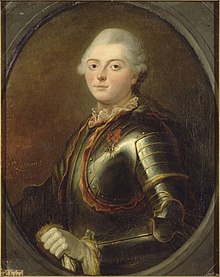Comte d'Estaing
| Charles Hector, comte d'Estaing | |
|---|---|

Portrait by Jean-Baptiste Le Brun, 1769
|
|
| Born |
24 November 1729 Château de Ravel, Auvergne |
| Died | 28 April 1794 (aged 64) Paris |
| Allegiance |
|
| Service/branch |
|
| Rank | Lieutenant General, Admiral |
| Battles/wars |
War of the Austrian Succession |
War of the Austrian Succession
Seven Years' War
American War of Independence
Jean Baptiste Charles Henri Hector, comte d'Estaing (24 November 1729 – 28 April 1794) was a French general and admiral. He began his service as a soldier in the War of the Austrian Succession, briefly spending time as a prisoner of war of the British during the Seven Years' War. Naval exploits during the latter war prompted him to change branches of service, and he transferred to the French Navy.
Following France's entry into the American War of Independence in 1778, he led a fleet to aid the American rebels. He participated in a failed Franco-American siege of Newport, Rhode Island in 1778 and the equally unsuccessful 1779 Siege of Savannah before returning to France in 1780. His difficulties working with American counterparts are cited among the reasons these operations failed.
Although he sympathized with revolutionaries during the French Revolution, he held a personal loyalty to the French royal family. Because of this he came under suspicion, and was executed by guillotine in the Reign of Terror.
He was born on 24 November 1729 at the Château de Ravel in Auvergne to Charles-François, the Marquis de Saillant and Marie-Henriette Colbert de Maulevrier, a descendant of Jean-Baptiste Colbert. His father was a lieutenant general in the French Army from a family with a long history of service to the French crown. The young d'Estaing was educated alongside Louis, the Dauphin (father of the future Louis XVI), who was born at about the same time. D'Estaing thus became close friends with the Dauphin and served in his retinue.
...
Wikipedia
